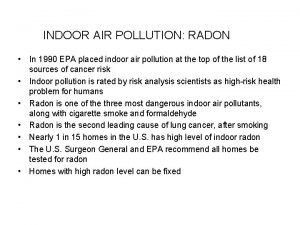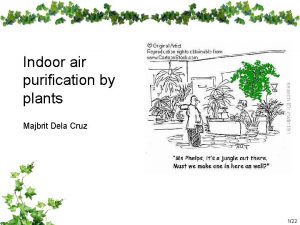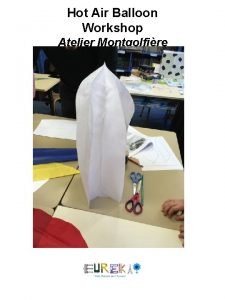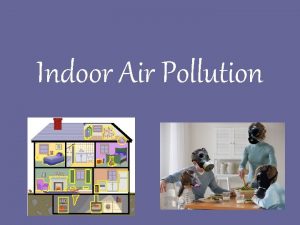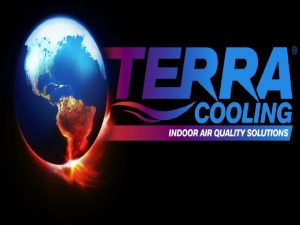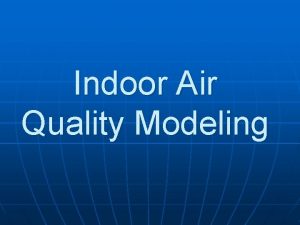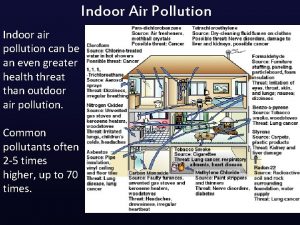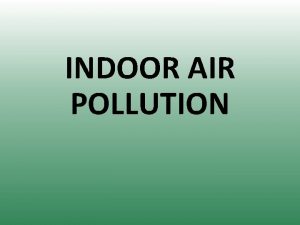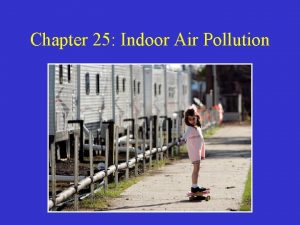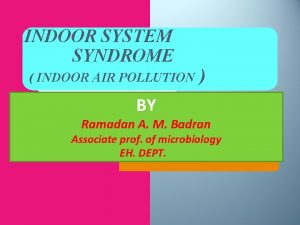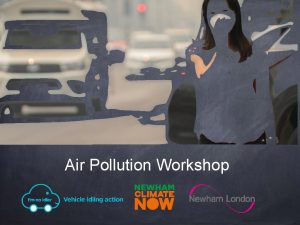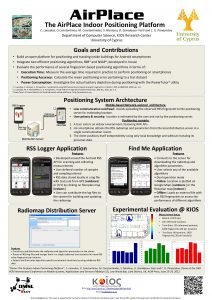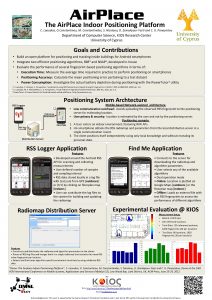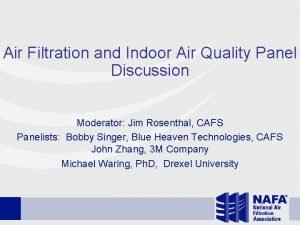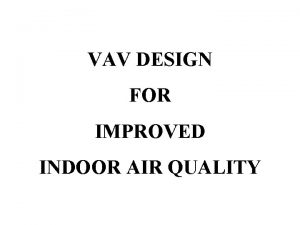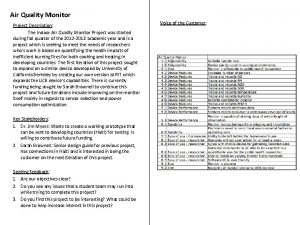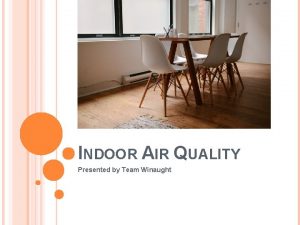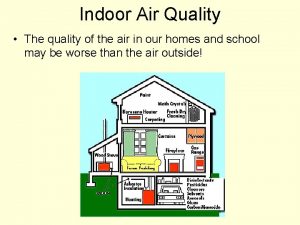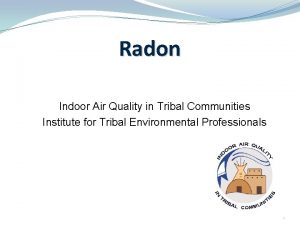Indoor Air Institute Workshop SVOCs in the Indoor



















![Measured vs. estimated [SVOCs] on hands Weschler & Nazaroff, Atmos. Environ. , 2008 Measured vs. estimated [SVOCs] on hands Weschler & Nazaroff, Atmos. Environ. , 2008](https://slidetodoc.com/presentation_image_h/8c7d5159d35d863999663ff74399c2a8/image-20.jpg)
![Measured vs. estimated [SVOCs] in dust Nazaroff & Weschler, Healthy Buildings, 2009 Measured vs. estimated [SVOCs] in dust Nazaroff & Weschler, Healthy Buildings, 2009](https://slidetodoc.com/presentation_image_h/8c7d5159d35d863999663ff74399c2a8/image-21.jpg)







- Slides: 28

Indoor Air Institute Workshop: SVOCs in the Indoor Environment Brief Report by John Little Virginia Tech

Motivation for SVOC Workshop • Semi-Volatile Organic Compounds (SVOCs) include: – Plasticizers, flame retardants, pesticides, combustion products, anti-stain agents, heat transfer fluids • SVOCs are ubiquitous indoors, redistributing from their original sources to indoor air, and subsequently to all interior surfaces including airborne particles, dust, and human skin • Concern about exposure and health effects including endocrine disruption and asthma

“Pilot” SVOC Workshop at EPA • Organizational Sponsor • Indoor Air Institute • Financial Sponsors • EPA (NERL, HEASD – Roy Fortmann; NCCT – Robert Kavlock) and ACC LRI (Tina Bahadori) • Date • August 17 to 19, 2009 • Co-Chairs • John Little and Elaine Cohen Hubal • Steering Committee • Bill Fisk, Hal Levin, Tom Mc. Kone, Bill Nazaroff, Charlie Weschler • Invited Participants • Harvey Clewell, Miriam Diamond, John Kissel, Vickie Wilson

SVOC Workshop Questions 1. Can we characterize the source-to-effect continuum for one class of SVOCs (phthalates)? 2. Can the overall mechanistic risk assessment approach be generalized to other SVOCs? 3. Can we identify screening-level, rapid exposure assessment approaches?

Series of Presentations • Tox. Cast. TM and Expo. Cast. TM for prioritization and chemical evaluation • Elaine Hubal, EPA, National Center for Computational Toxicology • Sources, emissions, transport, exposure and rapid screening for exposure • John Little, Virginia Tech • The mismeasure of dermal absorption • John Kissel, University of Washington • PBPK measurements, modeling, and metabolic reactions • Harvey Clewell, The Hamner Institutes • Organ-specific toxic effects of phthalates • Vickie Wilson, EPA, Reproductive Toxicology Division • Models in environmental regulatory decision making • Tom Mc. Kone, UC Berkeley and LBNL

SVOC Workshop Questions 1. Can we characterize the source-to-effect continuum for one class of SVOCs (phthalates)? 2. Can the overall mechanistic risk assessment approach be generalized to other SVOCs? 3. Can we identify screening-level, rapid exposure assessment approaches?

SVOC Emissions model + particles yin= 0, TSP, Q q = K sy ……. V y(t) Ai y(t), TSP, Q ……. qp = Kpy. TSP ……. Particles x=L x=0 A C 0 = Ky 0 C 0 h D x (Xu and Little, 2006 ) 7

Emissions of DEHP from vinyl flooring Xu et al. , 2008

Make model more representative of real indoor environment 9

Two-Room Model 10

Partition coefficients for DEHP Surface Partition coefficient, Ks Furniture, wall and ceiling 2500 (m) Carpet 1700 (m) Skin Airborne Particles 9500 (m) 0. 25 (m 3/μg) 11

Residential Environment 12

Residential Environment Compartment Volume (m 3) Flow rate (m 3/h) Surface area (m 2) Vinyl flooring Walls & Ceilings Carpet Wood floor Hard surface furniture Windows & mirrors Tile & ceramic fixtures TSP (mg/m 3) Main house 128 Qoa 65 Qao 44 Kitchen 35 Qok 12 Qko 32 Qak 44 Qka 24 Bathroom 15 Qob 1. 1 Qbo 2. 1 Qab 14 Qba 13 19. 2 124 35. 8 32. 0 61. 4 5. 12 20. 0 14. 4 34. 0 --12. 6 1. 75 3. 50 20. 0 6. 20 23. 3 --5. 40 1. 05 16. 5 20. 0 13

Residential Model Predictions 14

Exposure for Child (2 to 3 yrs) 25 0. 6 0. 5 0. 4 15 0. 3 0. 2 10 0. 1 Total Exposure (μg/kg/day) 20 Ingestion (Dust) 5 0 Dermal Inhalation (Air+Particle) 0 -0. 1 0 100 200 300 Time (days) 400 500 15

Source to Effect Continuum • Sources, emissions, transport, exposure and rapid screening for exposure • John Little, Virginia Tech • Dermal absorption • John Kissel, University of Washington • PBPK measurements, modeling, and metabolic reactions • Harvey Clewell, The Hamner Institute • Organ-specific toxic effects of phthalates • Vickie Wilson, EPA, Reproductive Toxicology Division

SVOC Workshop Questions 1. Can we characterize the source-to-effect continuum for one class of SVOCs (phthalates)? 2. Can the overall mechanistic risk assessment approach be generalized to other SVOCs? 3. Can we identify screening-level, rapid exposure assessment approaches?

Indoor SVOC Dynamics Weschler and Nazaroff, Atmos. Environ. , 2008

Estimating physical properties with structure-activity relationships (SPARC) Weschler & Nazaroff, Atmos. Environ. , 2008
![Measured vs estimated SVOCs on hands Weschler Nazaroff Atmos Environ 2008 Measured vs. estimated [SVOCs] on hands Weschler & Nazaroff, Atmos. Environ. , 2008](https://slidetodoc.com/presentation_image_h/8c7d5159d35d863999663ff74399c2a8/image-20.jpg)
Measured vs. estimated [SVOCs] on hands Weschler & Nazaroff, Atmos. Environ. , 2008
![Measured vs estimated SVOCs in dust Nazaroff Weschler Healthy Buildings 2009 Measured vs. estimated [SVOCs] in dust Nazaroff & Weschler, Healthy Buildings, 2009](https://slidetodoc.com/presentation_image_h/8c7d5159d35d863999663ff74399c2a8/image-21.jpg)
Measured vs. estimated [SVOCs] in dust Nazaroff & Weschler, Healthy Buildings, 2009

SVOC Workshop Questions 1. Can we characterize the source-to-effect continuum for one class of SVOCs (phthalates)? 2. Can the overall mechanistic risk assessment approach be generalized to other SVOCs? 3. Can we identify screening-level, rapid exposure assessment approaches?

Zero-Order Exposure Screening • Excretion to production ratio (EPR): – Ratio of the rate of excretion from humans (urine) to the rate of manufacture provides rough exposure indicator – Dietary supplements or pharmaceuticals: EPR ~ 1. 0 – Personal care products: EPR ~ 0. 01 to 1 – Pesticides: EPR ~ 0. 0001 -0. 01 – Additives in indoor products: EPRs ~ 0. 1 -100 ppm • Some estimated EPRs: – Triclosan ~ 8000 ppm – Pentachlorophenol ~ 500 ppm – DEHP ~ 20 ppm

First-Order Exposure Screening • Exposure to additives (e. g. , plasticizers and flame retardants): – Steady state concentration y (and hence exposure) depends primarily on y 0, A and h – y 0 may be roughly equal to vapor pressure

At Steady State • • • Q~normal(50, 20) Kp~normal(0. 25, 0. 05) TSP~normal(20, 5) h is correlated with Q 50000 random trials 25

Variability in Predicted Steady. State Gas-Phase Concentration 26

Rapid Exposure Screening • Zero-Order Screening – Excretion to production ratio (EPR) • Triclosan ~ 8000 ppm • Pentachlorophenol ~ 500 ppm • DEHP ~ 20 ppm • First-Order Screening – Exposure to additives (e. g. , plasticizers and flame retardants)

SVOC Workshop Outcomes 1. Can we characterize the source-to-effect continuum for phthalates? ~Yes 2. Can the overall mechanistic approach be generalized to other SVOCs? ~Yes 3. Can we identify screening-level, rapid exposure assessment approaches (and combine with info from Tox. Cast. TM to estimate risk)? ~Yes 4. Summary paper being prepared for publication 5. SVOC Workshop 2 planned for end of 2010 or early 2011
 Air higroskopis air kapiler dan air gravitasi
Air higroskopis air kapiler dan air gravitasi Radon indoor air pollution
Radon indoor air pollution Prevention of indoor air pollution
Prevention of indoor air pollution Indoor air pollutants
Indoor air pollutants Indoor air pollution examples
Indoor air pollution examples Montgolfire
Montgolfire Trời xanh đây là của chúng ta thể thơ
Trời xanh đây là của chúng ta thể thơ Bảng số nguyên tố lớn hơn 1000
Bảng số nguyên tố lớn hơn 1000 đặc điểm cơ thể của người tối cổ
đặc điểm cơ thể của người tối cổ Tỉ lệ cơ thể trẻ em
Tỉ lệ cơ thể trẻ em Vẽ hình chiếu vuông góc của vật thể sau
Vẽ hình chiếu vuông góc của vật thể sau Các châu lục và đại dương trên thế giới
Các châu lục và đại dương trên thế giới ưu thế lai là gì
ưu thế lai là gì Sơ đồ cơ thể người
Sơ đồ cơ thể người Môn thể thao bắt đầu bằng chữ f
Môn thể thao bắt đầu bằng chữ f Tư thế ngồi viết
Tư thế ngồi viết Hình ảnh bộ gõ cơ thể búng tay
Hình ảnh bộ gõ cơ thể búng tay Cái miệng nó xinh thế
Cái miệng nó xinh thế Mật thư tọa độ 5x5
Mật thư tọa độ 5x5 Tư thế ngồi viết
Tư thế ngồi viết Thứ tự các dấu thăng giáng ở hóa biểu
Thứ tự các dấu thăng giáng ở hóa biểu Gấu đi như thế nào
Gấu đi như thế nào Thẻ vin
Thẻ vin Thơ thất ngôn tứ tuyệt đường luật
Thơ thất ngôn tứ tuyệt đường luật Các châu lục và đại dương trên thế giới
Các châu lục và đại dương trên thế giới Sự nuôi và dạy con của hươu
Sự nuôi và dạy con của hươu Từ ngữ thể hiện lòng nhân hậu
Từ ngữ thể hiện lòng nhân hậu Thế nào là hệ số cao nhất
Thế nào là hệ số cao nhất Diễn thế sinh thái là
Diễn thế sinh thái là

